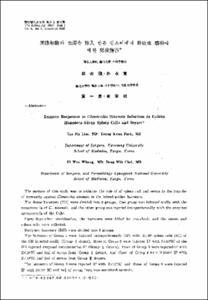비장세포와 혈청을 이입받은 햄스터에서 간흡충 감염에 대한 면역응답
- Keimyung Author(s)
- Lim, Tae Jin; Park, Young Kwan
- Department
- Dept. of Surgery (외과학)
- Journal Title
- Keimyung Medical Journal
- Issued Date
- 1987
- Volume
- 6
- Issue
- 2
- Abstract
- The purpose of this study was to estimate the role of spleen cell and serum in the transfer of immunity against Clonorchis sinensis in the inbred golden hamsters. The donor hamsters (DH) were divided into 2 groups. One group was infected orally with the metacercaria of C. sinensis, and the other group was injected intraperitoneally with the excysted metacercaria of the fluke. Forty days after sensitization, the hamsters were killed by anesthesia and the serum and spleen cells were collected. Recipient hamsters (RH) were divided into 6 groups. The hamsters of Group 1 were injected intraperitoneally (IP) with 2×10⁶ spleen cells (SC) of the DH infected orally (Group I donor), those of Group 2 were injected IP with 2×10⁶SC of the DH injected excysted metacercariae IP (Group II donors), those of Group 3 were injected IP with 2×10⁶SC and 1m1 of serum from Group I donors, and those of Group 4 were injected IP with 2×10⁶SC and 1m1 serum from Group II donors. The hamsters of Group 5 were injected IP with 2×10⁶SC and those of Group 6 were injected IP with 2×16⁶SC and 1m1 of serum from non-sensitized controls. Seven days sfter primary sensitization , recipient hamsters were challenged orally with 30 metacercariae and Eggs per Gram (EpG) of fecal samples were counted from 15 to 49 days after challenge. RH were killed 50 days after challenge, and the transfer of immunity to the RH was determined by significant differences in EpG, mean worm burdens, and immune cells per spleen sensitized and non-sensitized groups. The eggs of C. sinensis in the all recipient groups appeared in the 15th day by the formalin-ether sedimentation, and EpG noted the 16th day by Stoll's egg counting techniques after challenge. The sudden increase of EpG, which assumed to be expelled the fluke into the intestinal tract, was noted in the 28th day in Groups 1,3,4 and the 31th day in group 2. However there was no sudden increase of EpG in non-sensitized control Groups 5 and 6. The hamsters of Groups 3 and 4 harbored less foukes than those of Groups 1,2,5, and 6 and the differences in mean worm burdens were significant by the paired T-test. The relatively small numbers of plaque forming cells were found in Groups 1,2,3, and 4, but no cells in Groups 5 and 6. It is assumed that the intraperitoneal injection of spleen cells and serum from the donor hamster infected orally with the metacercariae or injected intraperitoneally with the excysted larvae of C. sinensis caused the transfer of protective immunity to the recipient hamsters.
- Alternative Title
- Immune Responese to Clonorchis Sinensis Infection in Golden Hamsters Given Spleen Cells and Serum
- Publisher
- Keimyung University School of Medicine
- Citation
- 박영관 et al. (1987). 비장세포와 혈청을 이입받은 햄스터에서 간흡충 감염에 대한 면역응답. Keimyung Medical Journal, 6(2), 167–176.
- Type
- Article
- Appears in Collections:
- 2. Keimyung Medical Journal (계명의대 학술지) > 1987
1. School of Medicine (의과대학) > Dept. of Surgery (외과학)
Items in Repository are protected by copyright, with all rights reserved, unless otherwise indicated.
